Humboldt History
General
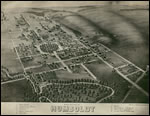 Although settlers were in the area as early as 1855, the original site of Humboldt was platted in 1868 and incorporated in 1873. There are several stories about the origin of the name. One is that it was named by Edward Tinker for a town in Tennessee where he was quartered during the Civil War. The other is that it was named by O.J. Tinker for Baron Friedrich Alexander von Humboldt, whom he admired.
Although settlers were in the area as early as 1855, the original site of Humboldt was platted in 1868 and incorporated in 1873. There are several stories about the origin of the name. One is that it was named by Edward Tinker for a town in Tennessee where he was quartered during the Civil War. The other is that it was named by O.J. Tinker for Baron Friedrich Alexander von Humboldt, whom he admired.
In 1867, the Nims brothers established the first store, located near the bridge on Long Branch. In 1869, the town founder O.J. Tinker offered Reuel Nims ten acres of land if he would build a store on the square, which became the first structure on the square. In 1871 Mr. Tinker deeded two acres of land to the city for the public square, and the bandstand in the center was added in 1912. The square later became the home of the Humboldt Fall Festival in 1921 which was merged with the Richardson County Fair in 1924.
 A post office was established and located in a store until 1875 when it occupied a building of its own. Early mail deliveries were made once a week by stage, but with the coming of the railway, daily mail began.
A post office was established and located in a store until 1875 when it occupied a building of its own. Early mail deliveries were made once a week by stage, but with the coming of the railway, daily mail began.
By 1879 Humboldt had a population of over 1,200, with a variety of businesses, including mercantile, mills, hotels, lumberyard, manufacturing, lawyers, doctors and even an osteopath. One early business, established by O.A. Cooper, was Humboldt Mills, later known as Cooper Feed, which was built in 1882. The original mill was a steam mill, later equipped with a roller system for making flour. Another early business was Marburger Shoes, which was begun by George F. Marburger in 1879, and is still in business today. The Humboldt Brick Company was established later in 1906. The high quality of the bricks was recognized with an ever-increasing demand. These bricks, stamped “Humboldt, Nebraska” can be found across the country as many were used by the Burlington Railroad.
 Public utilities were in the first rank for a town in its class. In 1894 a stand pipe with three miles of mains was approved. The standpipe served for 100 years before it was replaced. In connection with his mill, O.A. Cooper extended electrical lines and furnished light and power for much of the city. He also, with others, organized a telephone company in 1898.
Public utilities were in the first rank for a town in its class. In 1894 a stand pipe with three miles of mains was approved. The standpipe served for 100 years before it was replaced. In connection with his mill, O.A. Cooper extended electrical lines and furnished light and power for much of the city. He also, with others, organized a telephone company in 1898.
Several early doctors helped supply the health care needs of the town. Dr. James Gandy was the first physician in Humboldt and began his practice in 1869. Other medical people included: Mary Quick, who moved to Humboldt in 1867; Dr. P.F. Patrick, who came in 1872; Dr. J. Russell Morris, 1879; Dr. J.G. Cox, 1872; Dr. A.L. Williams, 1883; and Dr. P.W. Hays, 1879. There was no hospital in Humboldt until 1940 when Dr. Harlan Heim addressed the need and converted the O.A. Cooper residence. The first hospital had eleven beds for surgical and medical care, two cribs for children, and ten beds for care of the elderly. Still needing more space the Holman house was converted to a maternity hospital in 1949, with five beds and bassinets for maternity care and eighteen beds for elderly women. These were both closed when Community Memorial Hospital opened in 1967. Colonial Acres was built in 1969 to meet the community’s need for nursing home care.
Social pursuits were important to the town. Though preceded by a reading room, the current library was established in 1884 by Lydia Bruun Woods in memory of her first husband. The first band, organized by J.F. Walsh, was formed in 1873. Religion was also important with five churches: Christian, Methodist, German Methodist, Presbyterian, and Baptist, all being organized by 1875. Early newspapers included the People’s Paper, the Sentinel, the Farmer’s Advocate, the Nebraska Enterprise, the News, the Leader, and the Standard. Many of these papers are available on microfilm at the Library.
A large number of societies were available, and many people belonged to more than one. They included IOOF, Rebekah, IOGT, AF&AM, Temple of Honor, Knights of Pythias, William Mix Post (GAR), Bohemian Benevolent Society, Philharmonic Society, Delphian Society,Humboldt Horse Society, AOUW, Degree of Honor, Eastern Star, Modern Woodmen of the World and Triple Alliance.
In 1920 improvements were made when the dirt streets in the downtown area and the road to the depot were replaced with brick. Later the auditorium was constructed as a Works Progress Administration (WPA) project in 1942 using concrete and locally quarried limestone. Humboldt reached a peak population of 1455 in 1930, and the downtown reflects this prosperity, with modernization of existing buildings and construction of new buildings.
More recently a large 2-story mural depicting the town was created and painted on a building wall by Greg Holdren. And in 2005 the Humboldt Commercial Historic District was added to the National Register of Historic Places.
More historical information and a large collection of historical pictures can be found at Bruun Memorial Library.
| Top of Page |
Band Stand
 The land for the park was presented to the city January 12, 1871, by O.J. Tinker. The band stand was dedicated June 15, 1912, with the following account in the newspaper: “The Standard this week presents a view of the new band stand that was on last Saturday dedicated to the memory of O.J. Tinker, through whose beneficence the city was made the possessor of its beautiful park. Some idea of the immensity of the structure can be gleaned when it is known that more than seventy-five tons of cement,
The land for the park was presented to the city January 12, 1871, by O.J. Tinker. The band stand was dedicated June 15, 1912, with the following account in the newspaper: “The Standard this week presents a view of the new band stand that was on last Saturday dedicated to the memory of O.J. Tinker, through whose beneficence the city was made the possessor of its beautiful park. Some idea of the immensity of the structure can be gleaned when it is known that more than seventy-five tons of cement, 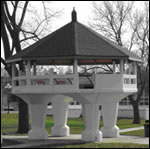 sand, shale and stay-rods were used in its construction, and furthermore the handling of this great bulk with the exception of a few inches of the top finish, which included the mixing of the “mud,” hoisting and placing in position, was completed in approximately ten hours. But willing hands were numerous and the finished product stands as mute evidence of the great force of cooperation. The building of the form or moulds was probably the most intricate part of the work, but in this the architect, Mr. Roy Reid, proved that he is a past-master of the art. After the opening selection by the band Rev. Cardy delivered an address, his remarks being supplemented by a short talk by Rev. Robertson.” (Humboldt Standard, June 21, 1912) About 1926 a roof was put on the band stand in the hopes that it might improve the acoustics, but this was not the case, and it was later removed. In the 1940s the possibility of razing it was discussed.
sand, shale and stay-rods were used in its construction, and furthermore the handling of this great bulk with the exception of a few inches of the top finish, which included the mixing of the “mud,” hoisting and placing in position, was completed in approximately ten hours. But willing hands were numerous and the finished product stands as mute evidence of the great force of cooperation. The building of the form or moulds was probably the most intricate part of the work, but in this the architect, Mr. Roy Reid, proved that he is a past-master of the art. After the opening selection by the band Rev. Cardy delivered an address, his remarks being supplemented by a short talk by Rev. Robertson.” (Humboldt Standard, June 21, 1912) About 1926 a roof was put on the band stand in the hopes that it might improve the acoustics, but this was not the case, and it was later removed. In the 1940s the possibility of razing it was discussed.
In 2005 the Rotary took on the project of repairing the band stand and putting the roof back on. The current roof was constructed by Nanninga Construction with help from the Humboldt Community Foundation.
| Top of Page |
Auditorium
 In 1941 the city received notification that the auditorium WPA application had been accepted and recommended for approval. A bond issue for $20,000 was approved for the city’s share of the construction, and by March the city had accepted bids. The stone for the project was quarried from the O.A. Cooper Co. farm. The buildings that occupied the auditorium site on the southwest corner of the square, previously had burned to the ground in August 1940, and when the workmen began to clear away the rubbish in July 1941, the fire restarted. By the end of September the excavation of the basement was complete, and the concrete was poured. After it was set, the stone work began, which was done by WPA labor. The laying of the cornerstone was observed with a ceremony on December 18 with band music and several talks. The floor of the main part of the auditorium, 63 by 82 feet, was poured in January 1942 and used 132 tons of crushed rock, 43 tons of sand and gravel, 780 sacks of cement, and about 10 tons of reinforcing steel. The auditorium was dedicated on December 9, 1942. According to the description in the newspaper, the finished building was 163 x 120 feet. The main floor was an auditorium 60 x 80 feet with a stage 20 x 60 feet. It also provided space for the city clerk’s office, council chambers, a ticket office and cloak room, and the entrance to the basement. Including the balcony, the auditorium had a seating capacity of 1,200. On the basement floor, there was a kitchen and several banquet rooms.
In 1941 the city received notification that the auditorium WPA application had been accepted and recommended for approval. A bond issue for $20,000 was approved for the city’s share of the construction, and by March the city had accepted bids. The stone for the project was quarried from the O.A. Cooper Co. farm. The buildings that occupied the auditorium site on the southwest corner of the square, previously had burned to the ground in August 1940, and when the workmen began to clear away the rubbish in July 1941, the fire restarted. By the end of September the excavation of the basement was complete, and the concrete was poured. After it was set, the stone work began, which was done by WPA labor. The laying of the cornerstone was observed with a ceremony on December 18 with band music and several talks. The floor of the main part of the auditorium, 63 by 82 feet, was poured in January 1942 and used 132 tons of crushed rock, 43 tons of sand and gravel, 780 sacks of cement, and about 10 tons of reinforcing steel. The auditorium was dedicated on December 9, 1942. According to the description in the newspaper, the finished building was 163 x 120 feet. The main floor was an auditorium 60 x 80 feet with a stage 20 x 60 feet. It also provided space for the city clerk’s office, council chambers, a ticket office and cloak room, and the entrance to the basement. Including the balcony, the auditorium had a seating capacity of 1,200. On the basement floor, there was a kitchen and several banquet rooms.
| Top of Page |
Churches
 Through the years Humboldt has had a variety of churches. It is generally accepted that the first church was the Christian Church, which was organized April 15, 1860. Early services were held in homes and in the school, and in the Methodist Church when it was erected. Their first building was completed in 1878.
Through the years Humboldt has had a variety of churches. It is generally accepted that the first church was the Christian Church, which was organized April 15, 1860. Early services were held in homes and in the school, and in the Methodist Church when it was erected. Their first building was completed in 1878.
About the same time (1860) the German Methodist church was begun as a mission church. The first church was built in 1879. They merged with the Methodist Episcopal Church in 1925.
The Methodist and Presbyterian churches began about the same time. Methodist Episcopal Church was organized by 1871 and erected the first church building in Humboldt in 1873. The Presbyterian Church was organized June 23, 1871 and held meetings in the school until 1878, when they completed their first building. After the German Methodist Church was razed, a new church was built, which became the home of the Holiness Church in 1928. After the church closed in 1968, the building was purchased in 1974 and became the home of the Berean Church. This congregation was organized in 1970, and later became the Bible Church. The Faith Lutheran Church (Missouri Synod) came later, and was organized in 1948. These churches are still in existence today. Another early church, the First Baptist Church, came into existence March 10, 1883. Their building was completed in 1884, but the church was short-lived and the building was torn down in 1925. Other churches, now defunct, in the area included Pleasant View (Methodist), Prospect (Evangelical), St. John’s (Hunzeker) and Advent (Seventh Day Baptist). Other present-day churches in the area include St. James (Longbranch) (Lutheran-ELCA) and Four-Mile.
| Top of Page |
Natorium/Swimming Pool
On June 28, 1914, a natatorium, located near the pumping station, was opened to the general public. The swimming pool was filled with Humboldt’s pure spring water, and was 80 feet  long, 30 feet wide, and graded in depth from 3 to 9 feet. It is unknown how long this pool remained open, but it had closed before World War II. The need for a new pool was realized, but because of the war, there was a shortage of some necessary materials, and plans were dropped. After the close of the war, there was new interest in a pool, and an engineer was employed to draw the plans and specifications. The initial project included only the pool proper and was completed in the fall of 1941. Due to the higher cost of materials and labor, there were not enough funds for equipment and the bathhouse. Another bond election, in the amount of $15,000, was held in December 1951 and passed 321 to 112. The new pool opened to the public Sunday, June 22, and was dedicated on the 4th of July with band music, diving, swimming and medley exhibitions, and a demonstration of life saving techniques. The speaker for the dedication was Guy Cooper, Sr.
long, 30 feet wide, and graded in depth from 3 to 9 feet. It is unknown how long this pool remained open, but it had closed before World War II. The need for a new pool was realized, but because of the war, there was a shortage of some necessary materials, and plans were dropped. After the close of the war, there was new interest in a pool, and an engineer was employed to draw the plans and specifications. The initial project included only the pool proper and was completed in the fall of 1941. Due to the higher cost of materials and labor, there were not enough funds for equipment and the bathhouse. Another bond election, in the amount of $15,000, was held in December 1951 and passed 321 to 112. The new pool opened to the public Sunday, June 22, and was dedicated on the 4th of July with band music, diving, swimming and medley exhibitions, and a demonstration of life saving techniques. The speaker for the dedication was Guy Cooper, Sr.
| Top of Page |
Schools
In 1867, the year Nebraska was admitted as a state and the year the town of Humboldt was plotted, the first school was organized. O.J. Tinker with several others furnished $300 to erect the first school house. The one-story stone building, located on Third Street east of the town square, was known as the Grant School. This building was used as a school for six years until Humboldt’s increasing population needed a large school building. A bond of $3,000 was voted, and the second school was built on Fourth Street. This school served the community for thirteen years, with the high school occupying the  upstairs. During later years conditions were so crowded that a small two-room building was used for the lower grades. To meet ever-changing conditions a third school was built in 1885. At a cost of $15,000, this two-story brick structure was 70 by 73 feet. In 1913 an addition was made, to house a gymnasium and the lower grades. In 1930 a new three-story school was built, which included all grades and a gymnasium. This building is still in use with a 1964 addition for the lower grades and a multi-purpose room and a 1969 addition for a new gymnasium, locker rooms, and music rooms. New offices were added more recently. Throughout most of the school’s history it was known as Humboldt Public School. But through a merger with Table Rock-Steinauer, the name was changed to HTRS (Humboldt-Table Rock-Steinauer). Since that time the district’s size has increased when it received half of the Dawson School District and then merged with the Southeast Nebraska (Stella) School. It is now the largest school district in the state in geographical area.
upstairs. During later years conditions were so crowded that a small two-room building was used for the lower grades. To meet ever-changing conditions a third school was built in 1885. At a cost of $15,000, this two-story brick structure was 70 by 73 feet. In 1913 an addition was made, to house a gymnasium and the lower grades. In 1930 a new three-story school was built, which included all grades and a gymnasium. This building is still in use with a 1964 addition for the lower grades and a multi-purpose room and a 1969 addition for a new gymnasium, locker rooms, and music rooms. New offices were added more recently. Throughout most of the school’s history it was known as Humboldt Public School. But through a merger with Table Rock-Steinauer, the name was changed to HTRS (Humboldt-Table Rock-Steinauer). Since that time the district’s size has increased when it received half of the Dawson School District and then merged with the Southeast Nebraska (Stella) School. It is now the largest school district in the state in geographical area.
| Top of Page |
Humboldt Fall Festival/Richardson County Fair
 In September 1920 the Humboldt Boosters called a meeting to discuss the possibility of a permanent annual community celebration. Though committees were appointed, delays and obstacles forced the event to be cancelled. In 1921 the Fall Festival was held with pens and stalls for the exhibit of livestock and farm products right on the square. Entertainment included tumbling and contortion, tight wire walking, and a band of Indians. In 1922 Errold Bahl gave a flying demonstration with numerous wing performances and a parachute leap. 1923 was the first reference to other exhibits: textiles and art, canning and baking, school and horticulture exhibits. Each exhibit was housed in a different downtown business.
In September 1920 the Humboldt Boosters called a meeting to discuss the possibility of a permanent annual community celebration. Though committees were appointed, delays and obstacles forced the event to be cancelled. In 1921 the Fall Festival was held with pens and stalls for the exhibit of livestock and farm products right on the square. Entertainment included tumbling and contortion, tight wire walking, and a band of Indians. In 1922 Errold Bahl gave a flying demonstration with numerous wing performances and a parachute leap. 1923 was the first reference to other exhibits: textiles and art, canning and baking, school and horticulture exhibits. Each exhibit was housed in a different downtown business.
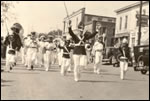 1924 was memorable in that it was the first year it was referred to as the Humboldt Fall Festival and Richardson County Fair. It was also the first year for the queen contest, won by Thelma Powell Stalder, and the first parade. In the early days it was the custom to have all the livestock exhibits in the parade. One novelty in 1925 was a pyrotechnical display from an airplane piloted by Errold Bahl. The newspaper reports an actual count of 3,320 cars in Humboldt on Friday of that year. In 1928 the Friday crowd was estimated at 12,000-15,000. Lincoln Telephone & Telegraph installed a loud speaker system on the platform in 1930 to enable everyone to hear any and all announcements made. In 1937 there was a special float in the parade with Humboldt resident Emmajo Newby, Miss Nebraska, on it.
1924 was memorable in that it was the first year it was referred to as the Humboldt Fall Festival and Richardson County Fair. It was also the first year for the queen contest, won by Thelma Powell Stalder, and the first parade. In the early days it was the custom to have all the livestock exhibits in the parade. One novelty in 1925 was a pyrotechnical display from an airplane piloted by Errold Bahl. The newspaper reports an actual count of 3,320 cars in Humboldt on Friday of that year. In 1928 the Friday crowd was estimated at 12,000-15,000. Lincoln Telephone & Telegraph installed a loud speaker system on the platform in 1930 to enable everyone to hear any and all announcements made. In 1937 there was a special float in the parade with Humboldt resident Emmajo Newby, Miss Nebraska, on it.
Five CCC buildings were purchased in 1939 and moved near the southwest corner of the square to provide a place to show many of the exhibits. A year later, a sale barn was built, and the Ag. Society was allowed to use it during the fair. In 1943 instead of the usual method of electing the queen, a bond queen was chosen. Votes were given with the sale of war bonds and stamps, and the coronation was held at the end of the fair. Another first happened in 1944 when Guy Cooper, Sr. was chosen as the first King.
and the Ag. Society was allowed to use it during the fair. In 1943 instead of the usual method of electing the queen, a bond queen was chosen. Votes were given with the sale of war bonds and stamps, and the coronation was held at the end of the fair. Another first happened in 1944 when Guy Cooper, Sr. was chosen as the first King.
Because of deterioration of the buildings, a new metal building for the exhibits was erected in 1972. Another big change came in 1987 when the days of the fair were changed to Thursday, Friday and Saturday with the coronation on Wednesday. In 2001 the old barn was leveled and a new livestock center was constructed.
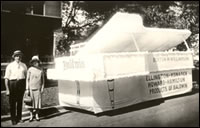 The coronation program marks the beginning of each fair with the crowning of the queen and king and a program centered around the fair theme. Throughout the years entertaining programs have been provided including political speeches, local talent, and paid performers. The parades have always been a high point of the fair with creative floats by churches, businesses and schools, as well as bands from many local schools, and a children’s parade. The midway is a favorite for the younger crowd, with rides and games being provided by Hale’s Shows and D.C. Lynch over the years. At times parking could be difficult. In the 1930s the newspaper reported that automobiles were parked from the standpipe in the north end of the city to the Burlington station at the extreme south side of the city. Rain during the Fair was common, sometimes causing the coronation to be delayed, parades to be cancelled, and even extending the fair an extra day.
The coronation program marks the beginning of each fair with the crowning of the queen and king and a program centered around the fair theme. Throughout the years entertaining programs have been provided including political speeches, local talent, and paid performers. The parades have always been a high point of the fair with creative floats by churches, businesses and schools, as well as bands from many local schools, and a children’s parade. The midway is a favorite for the younger crowd, with rides and games being provided by Hale’s Shows and D.C. Lynch over the years. At times parking could be difficult. In the 1930s the newspaper reported that automobiles were parked from the standpipe in the north end of the city to the Burlington station at the extreme south side of the city. Rain during the Fair was common, sometimes causing the coronation to be delayed, parades to be cancelled, and even extending the fair an extra day.
While there have been many changes over the years, much of the fair remains the same—the parades, the queen contest, the exhibits, and the free entertainment. The Humboldt Fall Festival and Richardson County Fair continues to be a community celebration and a community effort with the cooperation of the Chamber of Commerce, the Ag. Society, and many volunteers.
| Top of Page |
 Quad-County History & Research Center
Quad-County History & Research Center
Quad County Historical & Research Society aka Quad County Museum is located at 324 East Square. The Quad County Museum is accepting artifacts from Humboldt and surrounding communities to preserve the history of our whole area. For more information, e-mail Sandy Stalder.
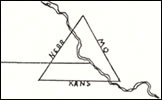 Tri-State Corners Genealogical Society
Tri-State Corners Genealogical Society
The society was founded in 1984, and represents the three state corners - Nebraska, Missouri and Kansas, with the Richardson County area as the primary interest. Meetings are at 7:30 on the first Thursday of each month, in the Pioneer Plaza meeting room at 1820 Barada Street in Falls City.
 Richardson County Historical Society
Richardson County Historical Society
1401 Chase St, Falls City NE
The museum houses a growing collection of items from the area, and an agricultural warehouse building is being constructed next door.

